关于武器贸易条约 (ATT) 的 50 条信息引述
近几个月来,《武器贸易条约》(ATT)是一个备受争议的话题,在国际上备受关注。第一个控制武器销售的协议,武器贸易条约于 2014 年 12 月 24 日生效,旨在控制可能被非法使用、造成伤害、造成破坏和侵犯人权的武器的非法贸易
充分控制此类武器的非法贸易对政治和人权都有重大影响,因为小武器和轻武器在帮派战争、有组织犯罪、内战和恐怖主义。随着对此类武器非法贸易的更大控制的愿望增加,有效追踪和追踪它们的需求也增加了。在 2001 年联合国行动纲领 (PoA) 和 2005 年国际追查文书 (ITI) 的基础上,《武器贸易条约》是数十年来关于加强军备控制必要性辩论的结晶。
基本上,《武器贸易条约》要求各国政府报告所有武器的销售情况,旨在减少可能用于在世界各地侵犯人权的武器的非法贸易和/或销售。随着网络上关于 ATT 的大量讨论,我们收集了来自与 ATT 相关的思想领袖和行业出版物的 50 条见解。这些摘录、引述和见解包括《武器贸易条约》的实施、需要 ATT 的令人信服的案例、后勤、数据管理和武器跟踪影响,以及围绕 ATT 对第二修正案权利的影响的担忧。
目录:
- 关于武器贸易条约
- 为什么需要《武器贸易条约》
- 非法武器贸易物流
- 武器贸易条约实施
- 数据管理、武器跟踪和报告
- 关于《武器贸易条约》是否侵犯第二修正案权利
关于武器贸易条约
《武器贸易条约》于 2013 年 4 月 2 日在联合国通过。目前已有 50 多个国家批准该条约,该条约将于 2014 年 12 月 24 日生效。以下引用和摘录提供了更多详细信息关于武器贸易条约的目的。
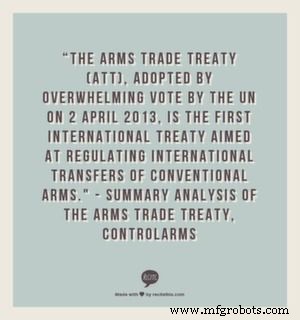
1. “联合国于 2013 年 4 月 2 日以压倒性多数票通过的《武器贸易条约》(ATT)是第一个旨在规范常规武器国际转让的国际条约。该条约虽然不完善,但为控制常规武器贸易的全球行动奠定了重要基础。它创建了一个新的全球规范,其他国家和国际公民社会将根据该规范来衡量各国的实践。” – 武器贸易条约概要分析 , ControlArms,推特:@controlarms
2. “该条约禁止各国出口违反武器禁运的常规武器,或用于种族灭绝、危害人类罪、战争罪或恐怖主义行为的武器。
“它还要求各国防止常规武器到达黑市。” – Barbara Plett,联合国以绝对多数通过历史性武器贸易条约 , BBC 新闻,推特:@BBCBarbaraPlett
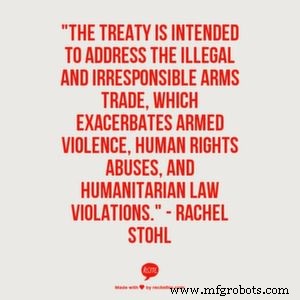
3. “《武器贸易条约》确立了政府在做出国际武器出口决定时必须适用的具体标准。该条约旨在解决加剧武装暴力、侵犯人权和违反人道主义法的非法和不负责任的武器贸易。该条约将特定标准应用于全球武器贸易,并要求各国政府将这些标准纳入其国家法律法规,以涵盖国际武器贸易的多个方面——特别是进口、出口、过境/转运和中间商。该条约制定了这些标准,以防止武器从合法市场转移到非法市场,并帮助减轻常规武器的传播对世界各地人民造成的破坏性影响。” – Rachel Stohl,武器贸易条约达到重要里程碑 , 史汀生,推特:@rachelstohl
4. “‘行业’是一个多元化的大社区。负责任的公司非常清楚需要一个全球规范来规范全球行业。与我们的政府和民间社会伙伴合作是一种独特而成功的经验。” – 劳斯莱斯战略出口控制总监 Andrew Wood,引自 50 庆祝 50
5.美国负责国际安全和防扩散事务的助理国务卿托马斯·康提曼 (Thomas Countryman) 在史汀生中心的一个公共论坛上说:“随着时间的推移,该条约‘将在促进作为谈判最初动机的人道主义目标方面产生影响’。华盛顿 4 月 5 日。“这将有助于减少向世界上最糟糕的人、在非洲和其他地方助长冲突的人提供武器。”
“该条约实现了‘两国之间的平衡’进口国和出口国的利益,”该条约的美国首席谈判代表 Countryman 说。 “最重要的是,”他说,它为这些国家以及“过境国”创造了义务。” ——美国负责国际安全和防扩散事务的助理国务卿托马斯·康提曼 (Thomas Countryman),正如杰夫·艾布拉姆森 (Jeff Abramson) 在《武器》(Arms) 中所引用的今日控制,特别报告:联合国大会以压倒性投票通过武器贸易条约 ,军备控制协会,推特:@jeffabramson
为什么需要武器贸易条约
《武器贸易条约》旨在为武器进出口提供一致的框架,以减少可能用于侵犯人权的武器非法贸易。暴力在世界许多地方越来越普遍; 《武器贸易条约》是限制获取冲突地区常用武器的重要第一步。
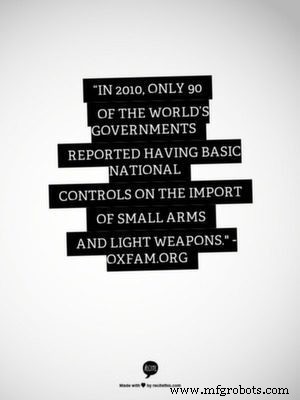
6. “2010 年,世界上只有 90 个政府报告对小武器和轻武器的进口进行了基本的国家控制。
“为什么国际武器贸易存在法律真空?
“因为世界已经从未同意制定一套关于武器贸易的国际规则。尽管这看起来令人难以置信,但我们在销售香蕉和 MP3 播放器方面拥有最繁琐的规则,但在军火贸易方面却没有可靠的、具有国际约束力的规则。” —— Oxfam.org,推特:@Oxfam
7. “通常基于执法和刑事司法系统记录的全国凶杀案数量之间的比较是有问题的。少报;各国法律制度在定义上的差异;记录做法的差异往往使各国无法比较犯罪数据。” – 使用生命登记数据追踪凶杀案 , 小武器调查新闻,Twitter:@SmallArmsSurvey
8. “常规武器被出售给世界冲突地区的武装战斗人员——苏丹、索马里、叙利亚、墨西哥、哥伦比亚、伊拉克、伊朗、克什米尔、缅甸、达尔富尔、刚果共和国以及其他国家和地区。这些武器经常被用来实施侵犯人权和暴行。妇女和儿童经常成为这些虐待的受害者。无限制的武器贩运助长了持续的武装战斗,破坏了整个地区的稳定,扰乱了生活的方方面面,并造成了大量难民。国际乐施会估计,非洲大陆每年因使用进口常规武器而损失至少 180 亿美元的经济活动——这一损失超过了对非洲国家的所有国际发展援助的年度总和。” – 艾琳·哈灵顿(Eileen Harrington),玛丽·安·麦吉文(Mary Ann McGivern)在 中引用 全国天主教记者 ,最初出现在内部 Loretto 时事通讯中,Interchange, 推特:@NCRonline
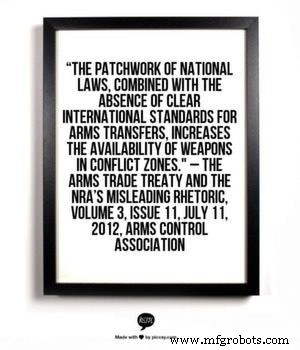
9. “叙利亚的持续冲突——最近在缅甸、刚果、利比里亚、苏丹和塞拉利昂发生的战争——强调了对常规武器和弹药国际转让的共同标准的迫切需要,以及对所有国家具有法律约束力的要求审查进出口——尤其是可能导致侵犯人权或违反国际武器禁运的武器转让。
“虽然美国和其他一些国家对武器贸易有相对严格的监管,但许多国家对武器贸易的监管薄弱
“国家法律的错综复杂,加上缺乏明确的武器转让国际标准,增加了冲突地区的武器供应。不负责任的武器供应商和经纪人可以利用这些条件向肆无忌惮的政府、犯罪分子和叛乱分子出售武器,包括那些与美军作战的人。” – 武器贸易条约和 NRA 的误导性言论 ,第 3 卷,第 11 期,2012 年 7 月 11 日, 军备控制协会,推特:@armscontrolnow
10. “据估计,每年约有 50 万人死于枪支。人们在战场上以及国家镇压和犯罪团伙中丧生。
“世界各地还有数百万人因被困在冲突引发的冲突中而无法获得医疗保健、水或食物而丧生。武器流动控制不佳。例如,在刚果民主共和国,自 1998 年以来,估计有超过 500 万人因武装冲突而间接死亡。
“对于在武装冲突和武装暴力中丧生的每一个人,我们都有考虑到更多的人在枪口下受伤和折磨、虐待、强迫失踪、被扣为人质或以其他方式剥夺了他们的人权。
“正如现在在叙利亚、伊拉克、利比亚和南苏丹。不负责任的武器交易迟早会在世界许多地方摧毁人们生活和生计的方方面面。” – 国际特赦组织的武器专家 Brian Wood,全球武器贸易条约 - 初学者指南:第 50 次批准更新 , 国际特赦组织,推特:@AmnestyOnline
11. “我希望每一位拥有武器出口权的官员——尤其是华盛顿、北京和莫斯科的官员——能够像我经历的那样,经历弹药不负责任地流入独裁者、军阀、凶残的毒品军队和民兵手中的人力成本它;
“上周在内罗毕发生的大屠杀凸显了减少枪支流入叙利亚政府等政府或总部位于索马里的 Al-使用常规武器犯下暴行的青年党。美国上周最终签署的《武器贸易条约》(ATT)就是为此而设计的。让我们希望美国的签名对中国和俄罗斯施加更大的政治压力,使其效仿。” – 美国国际特赦组织副执行主任 Frank Jannuzi,《杀戮场之旅:终于达成武器贸易条约》, 赫芬顿邮报,推特:@FrankJannuzi
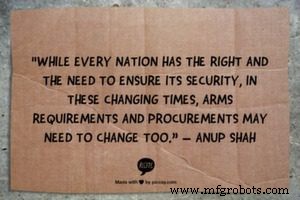
12. “武器贸易是侵犯人权的主要原因。一些政府在军费上的支出超过了社会发展、通信基础设施和健康支出的总和。虽然每个国家都有权利和需要确保其安全,但在这个不断变化的时代,武器需求和采购也可能需要改变。” – Anup Shah,武器贸易——痛苦的主要原因 , GlobalIssues.org,推特:@globalissuesorg
13.美国向外国领土提供武器——据报道,其中许多武器已经失去踪迹。 “一个政府监督机构表示,五角大楼已经丢失了它提供给阿富汗安全部队的 40% 以上的枪支,这促使官员们考虑采取‘胡萝卜加大棒’的方式来武装这支初出茅庐的军队。
“A定于周一公布的阿富汗重建特别监察长报告称,五角大楼追踪运往阿富汗的武器的两个主要信息系统——可靠后勤监督数据库的操作验证和安全合作信息门户——充满错误。” – Maggie Ybarra,报告:运往阿富汗的武器中有 40% 下落不明 , 华盛顿时报,推特:@WashTimes
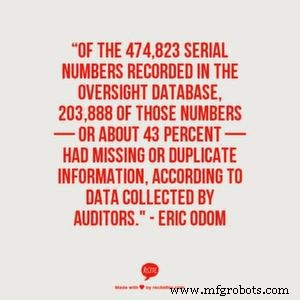
14.据自由新闻报道,“在过去十年中,五角大楼向阿富汗国家安全部队提供了超过 747,000 件武器和辅助设备,耗资 6.26 亿美元。步枪、手枪、机枪、榴弹发射器和霰弹枪等小型武器占这些武器的大部分。
“在监督数据库中记录的 474,823 个序列号中,其中有 203,888 个序列号,约占 43% — 根据审计师收集的数据,信息缺失或重复。审计人员在研究过程中发现,数据库中有 24,520 个序列号重复出现,而且通常不止一次,而且 50,304 个序列号没有附上发货或收货日期。
“一个被称为联合安保的多国军事编队阿富汗过渡司令部应该负责监督武器向安全部队的交付和转移。然而,审计人员收集的数据表明,安全指挥部没有达到问责要求。
“审计人员同样担心的是,阿富汗安全部队采用的枪支追踪方法是基于硬拷贝文件、手写文件的组合。报告称,记录和 Microsoft Excel 电子表格有时未正确输入系统。” – Eric Odom,武装敌人:五角大楼承认在阿富汗丢失了数十万件武器 , 自由新闻,推特:@ericjodom
15. “目前,管理香蕉和 iPod 国际销售的法律比榴弹发射器和 AK-47 还多。结果,在阿富汗杀死我们军队的子弹和军阀在非洲实施种族灭绝的武器都是在黑市上购买的,黑市在这种不受监管的环境中蓬勃发展。 《武器贸易条约》是阻止非法武器和弹药流向军阀、独裁者和恐怖分子的机会。” – 武器贸易条约 ,美国价值观网络,推特:@AmerValuesNet

16.经过多年的努力,几十年来对全球武器贸易的更严格监管的需求已经显而易见。在 2011 年的新闻稿中,“斯图尔特·普拉特上将、国防承包商、退伍军人和退役的美国海军少将明确支持进一步制定武器贸易法规:
”“战斗的性质正在发生变化。敌方战斗人员没有制服,因为他们躲在阴影中。作为负责任的国家,我们不伤害平民的愿望常常使我们的武装部队面临先发制人的风险。
“‘我们需要追踪武器、武器、致命战斗装备和工具的后勤轨迹。我们需要知道他们的去向,以便我们的领导人能够提前采取行动。我们需要了解武器流动的知识。
“‘现在对于这些非法军火商来说,今天的枪支走私者、走私者、恐怖分子,这些人深陷魔鬼的地狱。如果武器在阴暗的网络中自由流动,我们的武装部队将面临更大的风险。'”– 斯图尔特·普拉特上将,引用于信仰和军事领导人说维克多·布特的审判强调了武器贸易条约的必要性 ,美国价值观网络,推特:@AmerValuesNet
17.早在 2011 年,维克多·布特就成为围绕《武器贸易条约》必要性进行大量讨论的焦点。在一次采访中,前南非国会议员、《影子世界:全球武器贸易内部》一书的作者安德鲁·范斯坦 (Andrew Feinstein) 说, “正规军火贸易与‘影子世界’的界限极其模糊。像维克多·布特(现在在纽约受审)这样的人实际上已经为美国和联合国做过后勤工作。一个国家的国防部与大型军火生产商之间通常存在关系,而且其情报机构与非法交易商之间也存在关系。国际刑警组织发出逮捕布特九年的逮捕令,在那段时间里,美国在伊拉克和阿富汗使用他。” – 安德鲁·范斯坦(Andrew Feinstein),引用于快速研究:全球武器贸易——高度致命和高度监管不足 , Economist.com, Prospero, Twitter:@andrewfeinstein
非法武器贸易物流
非法武器贸易是一个普遍问题,对此类贸易的控制在很大程度上取决于各国维持更严格的后勤控制的能力。非法武器贸易物流是一个复杂的、相互交织的系统,在执行进出口管制方面面临着诸多挑战。

18. “今天小武器黑市的结构是一个遍布全球的复杂网络,吸走了全球化的收益。从本质上讲,必须绘制出非法武器贸易的结构,其中不仅包括黑市,还包括灰市和工艺品生产。
“小武器的旅程从合法电路开始,最终落入非法的魔掌.合法来源的武器有多种方式被转移到非法领域。通过危险路线运输、库存管理不善、抢劫、官员之间的腐败、战区缉获只是其中的一小部分。” – Aditi Malhotra,小武器的非法贸易 , 地缘政治监视器,推特:@GPMonitor
19. “除了具有约束力的联合国安理会武器禁运规定的具体义务外,许多国家已经认识到一些运输服务提供商在帮助将武器运输国际转移到未经授权或非法的最终用户或最终用途方面所发挥的作用。联合国打击小武器和轻武器非法经纪活动政府专家组 2007 年的报告承认了这一点,该报告建议鼓励所有国家通过其国家法律充分监管武器经纪活动“密切相关的活动”,包括“运输[和]货运代理”。 2007 年联合国大会决议鼓励所有国家执行该小组的建议,得到 179 个国家的支持,这些建议反映了联合国安理会设立的武器禁运调查小组的广泛调查结果,以及大赦国际和国际特赦组织的调查报告。其他非政府组织。这一广泛的详细调查工作突出了货运承运人、船舶和飞机所有者、航运经纪人、租船人和货运代理在向武器禁运国和武装反对团体以及那些承诺提供武器和弹药的运输中发挥的关键作用。严重违反国际法。” – 致命运动:武器贸易条约中的运输控制,ControlArms.org,Twitter:@controlarms
武器贸易条约实施
《武器贸易条约》为控制非法武器贸易的全球努力提供了总体关注点,但个别国家仍有权决定如何在其境内实施该条约。成功实施《武器贸易条约》还有很多工作要做。

20. “《武器贸易条约》概述了缔约国应履行的一些义务,以便该条约能够有效地规范国际武器转让以及防止和打击非法贸易。条约文本没有详细说明各国应如何履行这些义务,因为方法可能因国家而异。其他领域的经验表明,各国可以使用不同的机制来实现相同的目标。例如,监管军火中介活动的义务,例如相互介绍军火买家和卖家,可以通过为中介活动建立许可制度或完全禁止此类活动来实现。” – Paul Holtom 和 Mark Bromley,武器贸易条约的下一步:确保提前生效 , 军备控制协会,推特:@armscontrolnow
21. “这个三角形的所有三个方面,你都可以拥有全面的范围;你可以有严格的标准;但如果你没有健全的机制、系统和程序来让这些东西在实践中真正发挥作用,那一切都只是纸上谈兵。” – 罗伊·伊斯比斯特, 更安全的世界 小武器和转让控制小组组长,武器贸易条约实施网络研讨会 (推特:@Saferworld)。 在这段视频中,Isbister 指出,除了公共报告系统和持续讨论的论坛之外,各州还需要数据管理系统,以及项目、交易清单以及执行控制的权限和能力。
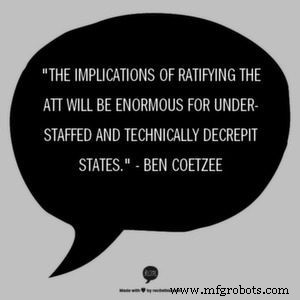
22. “ATT框架在得到总共50个州的批准或加入之前不会生效。迄今为止,已有六个国家批准了该条约,其中包括全球第三大武器贸易国德国。该框架的实施可能对较小的发展中国家构成问题,因为它需要基础设施和资源来监测非法过境点和其他非法武器贸易扩散的渠道。正如南非安全研究所的作者 Ben Coetzee 在他的文章“使武器贸易条约在实践中发挥作用是非洲面临的真正挑战”中指出的那样:“批准 ATT 对人员不足和技术上老旧的国家。'”– Lia Petridis Maiello,联合国倡议 UNSCAR:帮助小国实施武器贸易条约 (ATT) , 赫芬顿邮报,推特:@Lia_P_Maiello
23. “如果各国采用并成功实施《武器贸易条约》中确定的武器转让决定共同标准,不仅人类安全将得到加强,当今日益全球化的世界中存在的各种监管方法也将得到协调。广泛实施共同标准将有助于“公平竞争”。负责任的出口商不负责任地助长不稳定,不符合他们的利益。监管不严的供应商进入市场会破坏国家和地区的稳定,并对符合当前国际安全框架的行业产生不利影响。此外,全球国防工业对全球供应链的依赖带来了巨大的机遇,而不同的国家监管制度可能会增加工业负担并使武器转让过程更加繁琐和昂贵,从而使业务复杂化。” – Rachel Stohl,无党派史汀生中心跨界管理倡议高级助理,协调国际武器贸易全球战略 , 国际关系和安全网络,Twitter:@rachelstohl
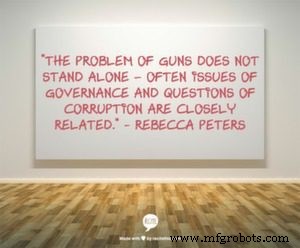
24.当被问及“如何确保枪支管制法的执行?” Rebecca Peters 回应说:“枪支问题并不孤立——通常治理问题和腐败问题密切相关。许多存在武装暴力问题的国家的警察往往不努力执行枪支管制法,或者自己参与非法枪支交易。众所周知,警察滥用武器或滥用职权。所有这些都促成了公民武装的愿望——他们自己的政府未能保护他们,或者实际上是在积极攻击他们。
“此外,必须制定适当的政策,以便他们可以顺利实施。例如,枪支法应确保所有武器都经过注册,就像汽车一样。许多法律要求枪支在购买后才进行注册,从而有效地使注册成为可选的。在一些国家,卖家必须在购买枪支时进行交易登记,而买家在完成登记程序之前不能拥有枪支。
“有时法律的设计方式会损害他们自己的利益有效性——在交易中注册枪支的时间点可能看起来很小,但实际上会产生重大影响。 IANSA 帮助制定关于民用枪支的有效法律的原则,以确保法律有最大的执行机会。此外,有效执法将取决于提高警察的诚信和记录保存能力。” – 国际小武器行动网络 IANSA 主任 Rebecca Peters,引自 IRIN 新闻,推特:@irinnews
25. “《武器贸易条约》要求成员国监督武器出口,并确保武器不会跨越现有的武器禁运或最终被用于侵犯人权,包括恐怖主义。在联合国的协助下,成员国将制定可执行的、标准化的武器进出口法规(很像美国已经存在的那些),并有望追踪出口目的地,以确保它们不会最终落入在坏人手中。理想情况下,这意味着限制致命武器流入叙利亚等地。” – Noah Rayman,联合国的真实新闻:美国签署武器贸易条约 , 时间,推特:@noahrayman
26. “人们普遍认为,《武器贸易条约》(ATT)将主要在国家层面实施,国际武器转让由个别国家做出决定。政府对由超国家机构做出许可或授权决定几乎没有兴趣。因此,为了全面实施《武器贸易条约》,所有国家都需要一个国家系统来控制常规武器的国际转让,其中包括能够实现许可/授权条款、执行机制和外部通信功能的法律、法规和行政程序和能力(包括,例如,允许与工业界联系的机制、就其国际武器转让活动编写报告的能力,以及发布和回应关于国际武器转让事宜的信息请求的能力)。
“在为了支持和促进《武器贸易条约》的实施,还需要提供国际机制和结构,除其他外:确保有意义的报告、信息共享、记录保存和透明度;允许缔约国就与条约适用有关的问题进行对话;促进缔约国之间的合作以及为实施提供和协调适当的援助;并促进问题解决、争端管理和持续的条约维护和发展。这些方面中的许多方面是相互依赖的,因为任何一方所采用的方法都会对其他人产生影响。” – 武器贸易条约的实施框架 , 更安全的世界,推特:@Saferworld
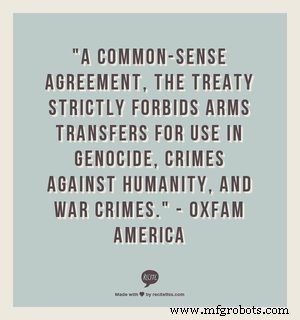
27. 《武器贸易条约》必须得到至少 50 个国家的批准才能全面生效。美国乐施会分享了一个信息图表,描述了武器贸易条约的必要性,并指出,“美国国务卿约翰克里于 9 月 25 日在纽约签署了武器贸易条约。
“世界上最大的武器出口国——美国——与其他 100 多个国家一起签署了第一个国际武器贸易条约。该条约是一项常识性协议,严格禁止将武器转让用于种族灭绝、危害人类罪和战争罪。乐施会敦促美国恪守条约的精神,在存在违反国际人权和人道主义法的重大风险(例如目前的叙利亚冲突中)的情况下,不批准任何武器转让。
“乐施会还呼吁美国参议院迅速批准该条约,并在一份新的简报中为这一重要步骤提出了强有力的论据,‘以常识拯救生命:美国继续支持《武器贸易条约》的理由。’条约在 50 个国家批准后生效。倡导者预计这将在 2014 年底之前发生。在美国,批准将需要三分之二的参议院同意。 – 现在是签订武器贸易条约的时候了 ,美国乐施会,推特:@Oxfam
28. 《武器贸易条约》已经达到 50 个批准的基准,这意味着它将在 2014 年 12 月 24 日生效。“随着国家支持以前所未有的速度发展,《武器贸易条约》将于 2014 年 12 月 24 日生效, only 18 months after it was opened for signature.
“Eight states – Argentina, the Bahamas, Bosnia and Herzegovina, the Czech Republic, Saint Lucia, Portugal, Senegal and Uruguay – ratified the Arms Trade Treaty (ATT) at a special event at the United Nations this past Thursday, Sep. 25, pushing the number of states parties up to 53.
“As per article 22 of the treaty, the ATT comes into force as a part of international law 90 days after the 50th instrument of ratification is deposited.
“According to a statement by the Control Arms coalition, 'The ATT is one of the fastest arms agreements to move toward entry into force.'” – Joel Jaeger, Arms Trade Treaty Gains Momentum with 50th Ratification , Inter Press Service News Agency, Twitter:@ipsnews
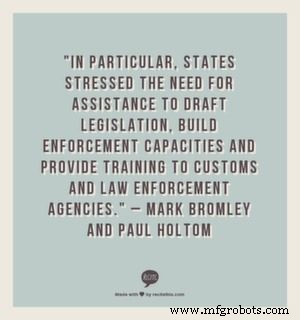
29. The need for more advanced states to assist those without the current frameworks, knowledge, or capacity to implement adequate systems to comply with the Arms Trade Treaty is one that’s been frequently addressed in the media, by analysts, and by organizations with vested interest in the advancement of the Arms Trade Treaty. “The adoption of the Arms Trade Treaty (ATT) in the United Nations General Assembly in April 2013 represented the successful conclusion of years of deliberations and negotiations among UN member states. During the process of negotiating the ATT a large number of states in the Global South stressed the need for the treaty to include provisions for financial, technical and material assistance aimed at helping states to fulfil treaty obligations. In particular, states stressed the need for assistance to draft legislation, build enforcement capacities and provide training to customs and law enforcement agencies. The challenges for states that do not have robust transfer control systems and which have limited capacities to implement the ATT were acknowledged by states in the Global North, which also indicated potential areas where assistance could be provided, such as establishing and strengthening legislative and administrative frameworks, and licensing and enforcement capacities.” – Mark Bromley and Paul Holtom, Arms Trade Treaty Assistance:Identifying a Role for the European Union , EU Non-Proliferation Consortium, Twitter:@SIPRIorg
Data Management, Weapons Tracking, and Reporting
Implementing the Arms Trade Treaty depends substantially on the implementation of consistent, adequate procedures for tracking weapons, reporting, and managing the volume of data required to maintain tighter control over arms trade among states. Some states will require the aid of those with more sophisticated technology in creating appropriate systems and procedures for weapons tracking and reporting.
30. “Article 10 of the ATT draft text allows states the freedom to record and report their arms trade ‘according to their national laws.’ States may ‘exclude commercially sensitive or national security information.’ The current proposal does not consider that the majority of states do not publish national reports on their arms exports and imports, and in several states the national regulations on transparency are minimal, include ineffective requirements, or are purposely weak, thereby reducing record-keeping to an exercise in creative administration. More often, verification mechanisms and law enforcement are underfunded or non-existent. If certain transfers are allowed to go unaccounted for under the guise of commercially sensitive or national security information, the ATT will provide an excuse for governments to hide information on the transfer of arms used in crimes, human rights violations and the excessive accumulation of conventional arms. Only a firm, robust, and mandatory framework for reporting can serve the purpose of a confidence-building ATT; vague, incomplete, unverifiable or ‘censored’ information will not. – Sergio Finardi, Brian Wood, Peter Danssaert, Ken Matthysen, The Arms Trade Treaty:Building a Path to Disarmament , Solutions, TransArmsUSA.org, Twitter:@SolutionsMag
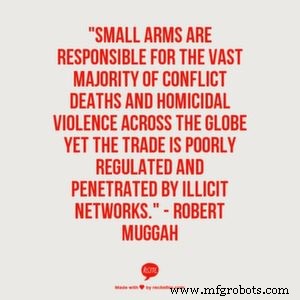
31. The control of global arms trade has been a subject of concern for decades. For instance, even in reports dating back to 1992 the need for a standardized system of tracking and recording data relating to the transfer of arms is presented in a report from the U.S. Congressional Budget Office:“Fundamental to any multilateral agreement to control arms exports would be a system for tracking, recording, and estimating the value of the transfers.” – Limiting conventional arms exports to the Middle East , United States Congressional Budget Office, excerpt via Google Books
32. “In his keynote address to the Stimson Center gathering, Assistant Secretary of State for International Security and Nonproliferation Thomas Countryman said that ‘providing defense equipment to reliable partners in a responsible manner actually enhances security, stability, and promotion of the rule of law.’
“He argued that a successful treaty would compel countries without adequate export controls to improve their national systems, but he cautioned that even a robust treaty would ‘not fundamentally change the nature of international politics nor can it by itself bring an end to the festering international and civil conflicts around the world.’
“Countryman also spoke about U.S. policy on some of the more contentious issues surrounding an ATT, including whether ammunition should be included within its scope. Although the United States already licenses its own import and export of ammunition, he said that the Obama administration had resisted incorporating ammunition because the logistics of monitoring end use through the ATT would be ‘hugely impractical.’”
“‘We have asked our international partners, who proposed this inclusion, to lay out some specific means where such a fungible and consumable commodity could effectively and practically be accounted for,’ said Countryman, adding that he was skeptical that a workable proposal for addressing ammunition through an ATT was at hand. Countryman gave a similar response in his interview with Arms Control Today (see page 21).” – Farrah Zughni, Hurdles for Arms Trade Treaty Underscored , Arms Control Association, Twitter:@armscontrolnow
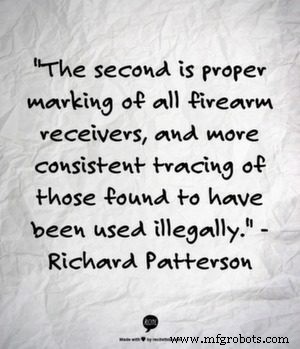
33. “We suggest there are two areas of focus where the United Nations can make a difference. The first is strict management of government stockpiles. The second is proper marking of all firearm receivers, and more consistent tracing of those found to have been used illegally.” – Richard Patterson, Managing Director, Sporting Arms and Ammunition Manufacturers’ Institute, Inc., First Committee of the General Assembly of the United Nations , SAAMI.org
34. “Other States are beginning the process of improving their national control systems to be in compliance with Treaty requirements. The ATT outlines a number of obligations for States Parties to fulfill in order to regulate international arms transfers and prevent and combat illicit trade. The Treaty text does not, however, provide specific details on how States should fulfill these obligations.
“Leading efforts in this endeavor is the Stimson Center and its partner at the University of Coventry, which have developed the Arms Trade Treaty – Baseline Assessment Project (ATT-BAP). The project’s premise is that to successfully implement the ATT, States must first identify their current requirements and needed capacities and resources. Many States have not cataloged their existing systems or identified the ways in which their capabilities can be applied to ATT implementation. The ATT-BAP helps States better understand these factors by providing a baseline assessment survey and ratification checklist to identify any necessary gaps in their current systems in order to effectively implement the Treaty. Upon completion of the ATT-BAP survey and ratification checklist, States will be able to identify what they already do, what they need to do, and what type of assistance they may require to implement the Arms Trade Treaty.
“Data from each completed survey will be used to highlight established best practices and recommend specific legislative and regulatory requirements and approaches needed for States to implement the provisions of the Treaty. This data will also serve as a tool for future ATT implementation projects, as well as those focused on monitoring the impact of and progress resulting from the Treaty’s adoption over time.” – Rachel Stohl, Establishing The Baseline – The Arms Trade Treaty, One Year Later , Stimson.org, Twitter:@rachelstohl
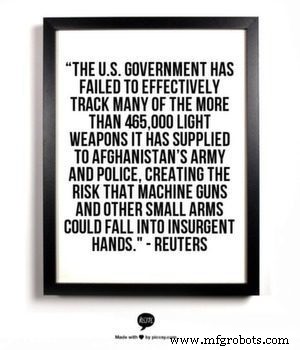
35. The present system in the U.S. for tracking the export of weapons is at times ineffective, according to reports. One July 2014 report appearing in Reuters notes, “The U.S. government has failed to effectively track many of the more than 465,000 light weapons it has supplied to Afghanistan’s army and police, creating the risk that machine guns and other small arms could fall into insurgent hands,” citing a report from the office of the Special Inspector General for Afghanistan Reconstruction (SIGAR), an independent U.S. government watchdog. The report “found that multiple databases maintained by the U.S. government often had missing or duplicate information about weapons provided to Afghan forces.”
The article goes on to cite additional problems beyond the U.S.’s tracking programs. “SIGAR said its investigation into weapons oversight found even more serious problems in the Afghan government’s system for keeping track of small arms once it receives them.” – U.S., Afghanistan fail to track U.S.-supplied small arms:watchdog , Reuters, Twitter:@ReutersWorld
36. “A global system for tracking illicit arms and ammunition is central to improving accountability in the international arms trade and preventing arms getting into the wrong hands. The United Nations negotiations to establish international Marking and Tracing controls present states with an historic opportunity to take a tough stance against the worldwide proliferation of illicit arms and the use of arms for violations of human rights and international humanitarian law and to make real progress.” – Marking and Tracing Arms and Ammunition:a central piece of the arms control puzzle, Control Arms , appearing on Essex.ac.uk, Twitter:@Uni_of_Essex
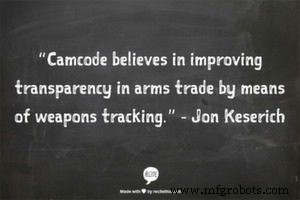
37. “Camcode believes in improving transparency in arms trade by means of weapons tracking,” said Jon Keserich, Managing Director. “What began as a program to help organizations identify, track and control property has now evolved into a mission to help defense organizations and nation states prevent illicit trade of weapons used in civil wars, terrorism, organized crime, gang warfare and other conflicts.” – Jon Keserich, Camcode Global, as quoted in a press release appearing on Benzinga, Twitter:@Camcode
38. “The tracing of illicit firearms is crucial component of the international strategy and framework to combat the illicit trade in small arms and light weapons in all its aspects.” – Interpol, Twitter:@INTERPOL_HQ

39. On the Mapping Arms Data project:“Drawing from existing data sources, the projectMAD website tracks the global trade in small arms, light weapons, and ammunition. Small arms are responsible for the vast majority of conflict deaths and homicidal violence across the globe yet the trade is poorly regulated and penetrated by illicit networks.
“The MAD project increases transparency and promotes accountability in the global trade of small arms and ammunition in order to understand how they threaten security and development throughout the world.” – Robert Muggah, the Igarapé Institute, Peace Research Institute Oslo (PRIO), appearing on MultipleJournalism.org
40. In a 2013 article discussing the challenges faced in controlling crime, particularly due to the lack of tracking mechanisms currently in place, Bloomberg reports, “Without a computer database, ATF traces a gun by contacting the manufacturer to identify the distributor, who will know the dealer. One of those three sources typically will be out of business, which forces ATF to sift through 445 million snapshot images of sales records, said Ginger Colbrun, a spokeswoman.” – Michael C. Bender, Gun Lobby Helps Block Data Collection by Crimefighters , Bloomberg, Twitter:@BloombergNews
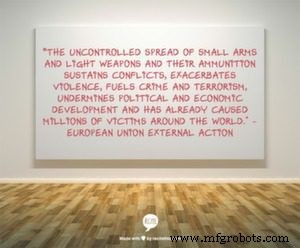
41. “The uncontrolled spread of small arms and light weapons and their ammunition sustains conflicts, exacerbates violence, fuels crime and terrorism, undermines political and economic development and has already caused millions of victims around the world.
“As part of its efforts to tackle this issue, the EU funds the iTrace project (Council Decision 2013/698/CFSP). It provides policy makers with precise, verified information on transfers of diverted small arms and light weapons (SALW), larger conventional weapons and ammunition. The project, which is implemented by Conflict Armament Research, combines an extensive programme of field investigations in conflict-affected countries with a powerful public access weapons tracking database.” – EU supports weapons tracking system iTrace , European Union External Action, Twitter:@eu_eeas
42. While the Arms Trade Treaty focuses on international imports and exports, there’s huge potential in gathering data on even domestic weapons, such as those used by police forces. In an article on Forbes, Aaron Tilley talks Internet-connected guns for police and how it may be the next step in new technology for police departments:“’There’s an overall transition with more sensors out there in the world to invade our privacy,’ said Jay Stanley, a senior policy analyst at ACLU’s Speech, Privacy and Technology Project, in a phone interview. ‘Using sensors to increase transparency with police officers is maybe a silver lining to all of this. … When the police shoot a gun, it’s a matter of public importance.’
“Like dash cams or body cameras on officers, the Yardarm sensor could be used to collect more data with what’s happening while officers are on duty. It could help reconstruct what actually happened after an incident.” – Aaron Tilley, Internet-Connected Guns Are The Next Step For Data-Hungry Police , Forbes, Twitter:@aatilley

43. There’s also talk about how the ATT impacts or overlaps with the UN Programme of Action to Prevent, Combat and Eradicate the Illicit Trade in Small Arms and Light Weapons in All Its Aspects (PoA). “The simple truth is that the practical and political impact of the ATT deliberations on the outcome of the 2nd Review Conference and the PoA process as a whole cannot be accurately predicted. What is clear, however, is that while the ATT has the potential to enhance and supplement the PoA provisions relating to international transfers, it cannot and should not be viewed as replacing the PoA in its entirety. International transfer controls are but one aspect of the PoA amid a broad range of arms control measures to which UN member states have committed themselves. The PoA offers a platform in terms of existing small arms control measures that could and should be built on in an ATT, and care should be taken to avoid contradiction and ensure complementarity between the two instruments. The PoA process also provides some lessons learned, including a lack of specificity and benchmarks that make implementation difficult to assess, and the absence of an extensive follow-up mechanism.” – Sarah Parker, An Arms Trade Treaty:Will It Support or Supplant the PoA? , SmallArmsSurvey.org Research Notes, Twitter:@SmallArmsSurvey
44. While the Arms Trade Treaty has been ratified by more than the 50 states required to facilitate its implementation, there’s still much work to be done. Namely, states must determine universal processes and systems for efficiently tracking the weapons imported and exported by individual states. The data gathered through this process will drive further decision-making. “In order for the ATT to fulfil its potential of bringing greater responsibility and transparency to the international arms trade, states parties and other ATT stakeholders will need to give thought to the mechanisms needed to enable effective treaty implementation and to facilitate universalization. While the treaty lays out a basic framework for implementation, many key decisions can only be taken after it enters into force.” – Sibylle Bauer, Paul Beijer, and Mark Bromley, The Arms Trade Treaty:Challenges for the First Conference of States Parties , SIPRI Insights on Peace and Security, Twitter:@SIPRIorg
On Whether the Arms Trade Treaty Infringes on Second Amendment Rights
There is much discussion among advocates for Second Amendment rights, with concerns being raised that the Arms Trade Treaty infringes on Americans’ right to bear arms. However, many experts have clarified the Arms Trade Treaty, noting that the ATT does not impact the trade or sale of arms within the United States; rather, the importing and exporting of weapons between the United States and other states around the world.

45. “I want to be clear both about what this treaty is, but I also want to be clear about what it isn’t. This is about keeping weapons out of the hands of terrorists and rogue actors. This is about reducing the risk of international transfers of conventional arms that will be used to carry out the world’s worst crimes. This is about keeping Americans safe and keeping America strong. And this is about promoting international peace and global security. And this is about advancing important humanitarian goals.
“I also want to be clear about what this treaty is not about. This treaty will not diminish anyone’s freedom. In fact, the treaty recognizes the freedom of both individuals and states to obtain, possess, and use arms for legitimate purposes. Make no mistake, we would never think about supporting a treaty that is inconsistent with the rights of Americans, the rights of American citizens, to be able to exercise their guaranteed rights under our constitution. This treaty reaffirms the sovereign right of each country to decide for itself, consistent with its own constitutional and legal requirements, how to deal with the conventional arms that are exclusively used within its borders.” – Secretary John Kerry, Remarks at the Arms Trade Treaty Signing Ceremony , as quoted by the U.S. Department of State, Twitter:@StateDept
46. “The treaty begins with a preamble that ‘reaffirms the sovereign right of any State to regulate and control conventional arms exclusively within its territory, pursuant to its own legal or constitutional system.’ This statement isn’t buried in some footnote; it’s found at the very beginning of the text. Now please correct me if I’m wrong, but doesn’t this mean that our government, and not the United Nations, gets to figure out how guns will be handled within the United States?
And what about the question of end users, because here’s where the NRA believes there lurks an attempt to create not just a national, but an international registry of all guns. I quote again from the treaty text:‘Each State Party shall maintain national records, pursuant to its national laws and regulations, of its issuance of export authorizations or its actual exports of the conventional arms…’ Now note what it says about imports:‘Each State Party is encouraged to include in those records:the quantity, value, model/type, authorized international transfers of conventional arms actually transferred, details of exporting State(s), importing State(s), transit and trans-shipment State(s), and end users, as appropriate.’
This is in fact no different than what U.S. exporters and importers must now do to comply with State Department and ATF regulations on export and import of small arms. These regulations are required to be followed by anyone who imports guns into the United States. But the operative word in the Treaty is encouraged; not required as in the case of U.S. law. Signatories to this treaty are not bound by any requirements to either compile lists of import end-users (which U.S. importers already compile) or deliver such lists to any international body. The only required record-keeping involves the destination of exports, and correct me if I’m wrong, but only American citizens possess Second Amendment guarantees.” – Mike Weisser, What Does The Arms Trade Treaty Really Say? , Huffington Post, Twitter:@HuffingtonPost

47. While many critics of the ATT express concern that the Treaty is merely the first step in a larger gun-grabbing attempt, proponents of the ATT continue to emphasize the fact that the Treaty focuses on international importing and exporting of weapons that are likely to be used to infringe upon human rights. “Rasha Abul-Rahim of Amnesty International thinks that though the U.S. has a large pro-gun population, it has taken steps to further regulate conventional arms sales.
“’Basically the directive pledges not to export arms where there’s a likelihood that the weapons transferred will be likely to be used for genocide or other atrocities, or will be used to violate human rights law or international humanitarian law,’ Abul-Rahim told german publication Deutsch Welle on Thursday. ‘This is a positive development and an indication that the U.S. could ratify in the future.’” – Rasha Abul-Rahim, Amnesty International, as quoted in U.S. advisory council responds to recent ratification of arms trade treaty , Guns.com, Twitter:@Guns_com
48. PolitiFact.com did some investigating into claims by the NRA and political leaders regarding the potential of the ATT to infringe upon Americans’ Second Amendment rights. “The National Rifle Association issued a statement after Secretary of State John Kerry signed the treaty saying it ‘threatens individual firearm ownership and an invasive registration scheme.’ Despite all signs to the contrary, the NRA and other groups opposed to the treaty insist it will create a slippery slope leading to a national gun registry.
“However, previous PolitiFact checks don’t back that up. PolitiFact Georgia, in an Aug. 12, 2012 story, interviewed legal experts and concluded, ‘…even in the unlikely event that the U.N. creates a treaty that provides for domestic registries and the U.S. Senate ratifies it, it would not ‘almost certainly force’ the U.S. to create one,’ as a Georgia congressman had alleged.” PolitiFact.com sums up this analysis with, “The claim is all flash and no powder. We rate it False.” – Dana Tims, Will the U.N. Arms Trade Treaty infringe on our right to keep and bear arms? , PolitiFact.com, Twitter:@PolitiFact

49. “The Arms Trade Treaty is consistent with America’s national security interests, foreign policy goals, business interests and moral traditions, which is why United States negotiators worked so hard to create it.
“So what’s behind the foreboding whispers? Some truly cynical domestic politics, it would appear.
“Those opposed to the accord have misrepresented what it does, suggesting that it would somehow infringe on American gun owners’ rights. It would do nothing of the kind.” – Rachel Stohl, Tell the Truth About the Arms Treaty , The New York Times, Twitter:@rachelstohl
50. Some political leaders, such as Texas Attorney General Greg Abbott, have recognized that the Arms Trade Treaty actually does not contain language that infringes on Second Amendment Rights, but continue to cite concerns that the ATT merely opens the door for future regulations that could, in fact, do so. But the American Bar Association squashes these fears:“Counter to Abbott’s claim that the United Nations would be able to interpret the treaty in a way that would violate individual ownership rights, the American Bar Association has concluded that Americans needn’t fear such an outcome. As the ABA points out in their white paper, import restrictions on firearms have been ruled constitutionally valid. At present, the Bureau of Alcohol, Tobacco and Firearms regulates and tracks the import of firearms into the United States, leaving no need for further domestic legislation regarding the ATT’s implementation.
“Exports of firearms, the ABA also notes, are not protected under the Second Amendment. Further, thanks to the efforts of countries like the United States, the ATT is not as strong as some advocates would prefer. Instead, the treaty is written to only affect the transfer of arms between states, not individuals, and only bars that transfer in the event of massive human rights violations on the level of crimes against humanity. The ABA does agree with Abbott, though, that any parts of the Arms Trade Treaty that would violate the Second Amendment would be rendered void.” – Hayes Brown, Texas Attorney General Admits Arms Treaty Doesn’t Violate Second Amendment , ThinkProgress.org, Twitter:@thinkprogress
Asset Tracking Solutions from Camcode:
- Asset Tags
- Property ID Tags
- Foil Labels
- 仓库标签
- Warehouse Signs
- Tamper Evident Labels
- 条码标签
- Rack Labels
- 悬挂标志
- UID 标签
- 仓库过道标志
- Stainless Steel Tags
- 地板标签
- Inventory Control
- Inventory Management Methods
工业技术


